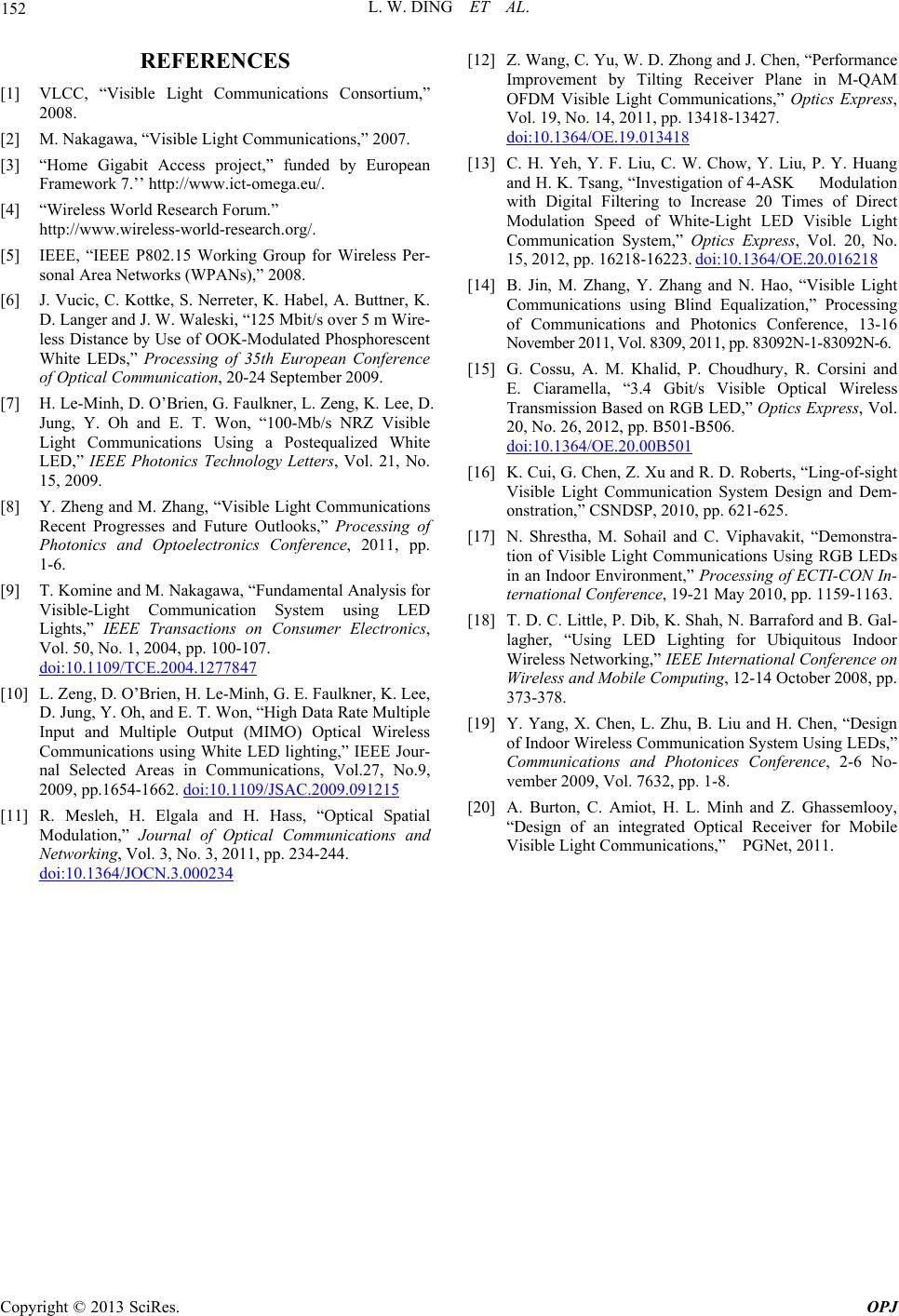
L. W. DING ET AL.
152
REFERENCES
[1] VLCC, “Visible Light Communications Consortium,”
2008.
[2] M. Nakagawa, “Visible Light Communications,” 2007.
[3] “Home Gigabit Access project,” funded by European
Framework 7.’’ http://www.ict-omega.eu/.
[4] “Wireless World Research Forum.”
http://www.wireless-world-research.org/.
[5] IEEE, “IEEE P802.15 Working Group for Wireless Per-
sonal Area Networks (WPANs),” 2008.
[6] J. Vucic, C. Kottke, S. Nerreter, K. Habel, A. Buttner, K.
D. Langer and J. W. Waleski, “125 Mbit/s over 5 m Wire-
less Distance by Use of OOK-Modulated Phosphorescent
White LEDs,” Processing of 35th European Conference
of Optical Communication, 20-24 September 2009.
[7] H. Le-Minh, D. O’Brien, G. Fa ulkner, L. Zeng, K. Lee, D.
Jung, Y. Oh and E. T. Won, “100-Mb/s NRZ Visible
Light Communications Using a Postequalized White
LED,” IEEE Photonics Technology Letters, Vol. 21, No.
15, 2009.
[8] Y. Zheng and M. Zhang, “Visible Light Communications
Recent Progresses and Future Outlooks,” Processing of
Photonics and Optoelectronics Conference, 2011, pp.
1-6.
[9] T. Komine and M. Nakagawa, “Fundamental Analysis for
Visible-Light Communication System using LED
Lights,” IEEE Transactions on Consumer Electronics,
Vol. 50, No. 1, 2004, pp. 100-107.
doi:10.1109/TCE.2004.1277847
[10] L. Zeng, D. O’Brien, H. Le-Minh, G. E. Faulkner, K. Lee,
D. Jung, Y. Oh, and E. T. Won, “High Data Rate Multiple
Input and Multiple Output (MIMO) Optical Wireless
Communications using White LED lighting,” IEEE Jour-
nal Selected Areas in Communications, Vol.27, No.9,
2009, pp.1654-1662. doi:10.1109/JSAC.2009.091215
[11] R. Mesleh, H. Elgala and H. Hass, “Optical Spatial
Modulation,” Journal of Optical Communications and
Networking, Vol. 3, No. 3, 2011, pp. 234-244.
doi:10.1364/JOCN.3.000234
[12] Z. Wang, C. Yu, W. D. Zhong and J. Chen, “Performance
Improvement by Tilting Receiver Plane in M-QAM
OFDM Visible Light Communications,” Optics Express,
Vol. 19, No. 14, 2011, pp. 13418-13427.
doi:10.1364/OE.19.013418
[13] C. H. Yeh, Y. F. Liu, C. W. Chow, Y. Liu, P. Y. Huang
and H. K. Tsang, “Investigation of 4-ASK Modulation
with Digital Filtering to Increase 20 Times of Direct
Modulation Speed of White-Light LED Visible Light
Communication System,” Optics Express, Vol. 20, No.
15, 2012, pp. 16218-16223. doi:10.1364/OE.20.016218
[14] B. Jin, M. Zhang, Y. Zhang and N. Hao, “Visible Light
Communications using Blind Equalization,” Processing
of Communications and Photonics Conference, 13-16
November 2011, Vol. 8309, 2011, pp . 83092N-1-83 092N-6.
[15] G. Cossu, A. M. Khalid, P. Choudhury, R. Corsini and
E. Ciaramella, “3.4 Gbit/s Visible Optical Wireless
Transmission Based on RGB LED,” Optics Express, Vol.
20, No. 26, 2012, pp. B501-B506.
doi:10.1364/OE.20.00B501
[16] K. Cui, G. Chen, Z. Xu and R. D. Roberts, “Ling-of-sight
Visible Light Communication System Design and Dem-
onstration,” CSNDSP, 2010, pp. 621-625.
[17] N. Shrestha, M. Sohail and C. Viphavakit, “Demonstra-
tion of Visible Light Communications Using RGB LEDs
in an Indoor Environment,” Processing of ECTI-CON In-
ternational Conference, 19-21 May 2010, pp. 1159-1163.
[18] T. D. C. Little, P. Dib, K. Shah, N. Barraford and B. Gal-
lagher, “Using LED Lighting for Ubiquitous Indoor
Wireless Networking,” IEEE International Conference on
Wireless and Mobile Computing, 12-14 October 2008, pp.
373-378.
[19] Y. Yang, X. Chen, L. Zhu, B. Liu and H. Chen, “Design
of Indoor Wireless Communication System Using LEDs,”
Communications and Photonices Conference, 2-6 No-
vember 2009, Vol. 7632, pp. 1-8.
[20] A. Burton, C. Amiot, H. L. Minh and Z. Ghassemlooy,
“Design of an integrated Optical Receiver for Mobile
Visible Light Communic ations,” PGNet, 2011.
Copyright © 2013 SciRes. OPJ